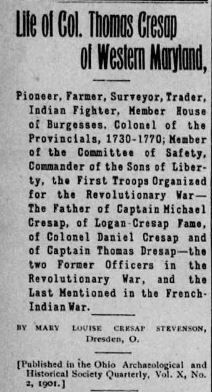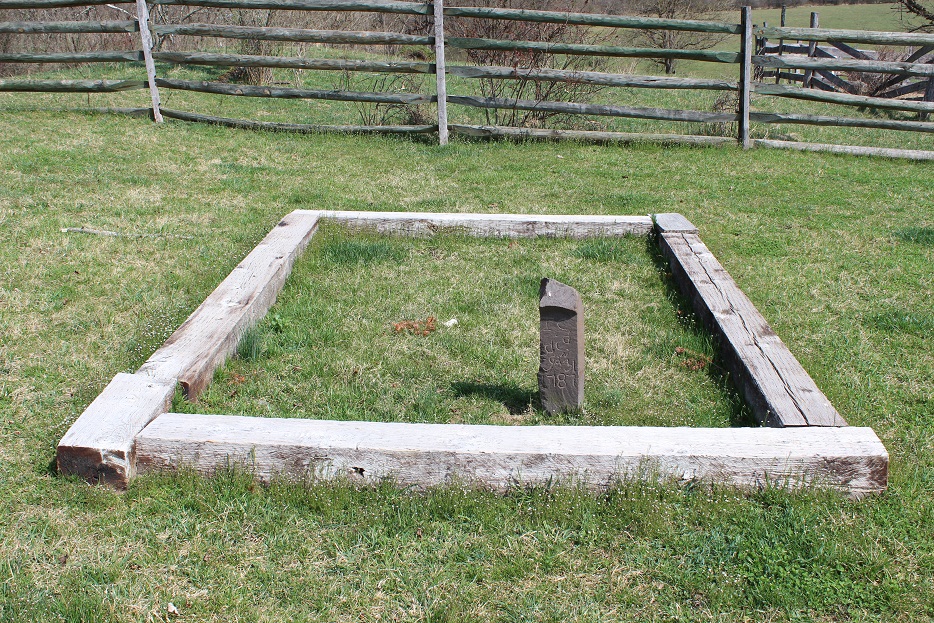Pathfinder, Pioneer, Patriot
These words are etched on a plaque.
Col Thomas Cresap was born around 1694 in Skipton, Yorkshire, England. He emigrated to Maryland in the 1710s. There he married Hannah Johnson in 1727. They had seven children.
He and his sons were pioneers who settled in what today is Washington County.
He died at his home in western Maryland on January 31, 1787.
(I am working on a bio fitting this amazing man and my ancestor. Below is a short biography by the public library of Frederick County).
Thomas Cresap (ca.1694-1787)
Thomas Cresap was Maryland's premier frontiersman. It can be easily
argued that he was the leading figure of mid-18th century Western Maryland.
Cresap was born in Skipton, Yorkshire, England. The year of his birth is
uncertain. At about age 15, he made the journey to America, settling in
Maryland. In 1729 he moved from near Havre de Grace up the Susquehanna
to what is now Wrightsville, Pennsylvania, where the governor of Maryland
had granted him five hundred acres he called Pleasant Garden. The land was
in dispute between the Calverts and the sons of William Penn, who contested
their common boundary. Cresap, who took it upon himself to represent
Maryland forcefully, killed encroaching livestock and shot at the posses sent
to arrest him until he was finally overcome and jailed in Philadelphia, which
he loudly declared to be "one of the Prettyest Towns in Maryland."
Pennsylvanians called him "the Maryland Monster." When lawyers from
both sides fought to an impasse, he was eventually released by order of the
Crown.
Back in Maryland, he moved west into the Allegheny mountains, where
he became a formidable Indian fighter, surveyor, trapper, trader, and land
speculator. In 1739 Cresap settled in the Cumberland Valley, near Antietam
Creek, in the vicinity of today's Hagerstown. He moved farther west in 1742,
settling along the Potomac River near today's Cumberland, in an area now
called Old Town. His new home, which he named Skipton, served as his base
for the rest of his long life.
Cresap became one of Frederick County's first justices and served in the
Lower House of the Maryland Assembly. He was active in both the French
and Indian War and the American Revolution. Along with Nemacolin, a
Native American chief, he cleared a trail between the Potomac and
Monongahela Rivers that would later serve as the route of the National
Road. Cresap was instrumental in opening up western Maryland for
settlement.
He was also a controversial figure. There are numerous tales, some true,
some false, giving the impression of a disagreeable man. He was accused of
the unprovoked killing of friendly Indians. He was accused of selling General
Edward Braddock's British expedition rotten meat. Cresap's various disputes
left a strong documentary trail for those interested in researching him.
Despite the dangers of the frontier, Cresap lived to a very old age,
reportedly to be over a hundred. He was most likely 93 upon his death. In his
youth he married Hannah Johnson. She died before 1774. They had at least
five children. Cresap's sons worked closely with him and were well known in
their own right, in particular Michael. There are over 11,000 reported
descendants of Thomas Cresap. The Cresap Society is a leading genealogical
association, preserving the memory of the man who is considered a pioneer,
pathfinder, and patriot.
—Mary Mannix
Frederick County Public Library∼Revolutionary War Veteran - per D.A.R. Patriot - member of Committee of Safety, signed Oath of Allegiance, Maryland.
Pathfinder, Pioneer, Patriot
These words are etched on a plaque.
Col Thomas Cresap was born around 1694 in Skipton, Yorkshire, England. He emigrated to Maryland in the 1710s. There he married Hannah Johnson in 1727. They had seven children.
He and his sons were pioneers who settled in what today is Washington County.
He died at his home in western Maryland on January 31, 1787.
(I am working on a bio fitting this amazing man and my ancestor. Below is a short biography by the public library of Frederick County).
Thomas Cresap (ca.1694-1787)
Thomas Cresap was Maryland's premier frontiersman. It can be easily
argued that he was the leading figure of mid-18th century Western Maryland.
Cresap was born in Skipton, Yorkshire, England. The year of his birth is
uncertain. At about age 15, he made the journey to America, settling in
Maryland. In 1729 he moved from near Havre de Grace up the Susquehanna
to what is now Wrightsville, Pennsylvania, where the governor of Maryland
had granted him five hundred acres he called Pleasant Garden. The land was
in dispute between the Calverts and the sons of William Penn, who contested
their common boundary. Cresap, who took it upon himself to represent
Maryland forcefully, killed encroaching livestock and shot at the posses sent
to arrest him until he was finally overcome and jailed in Philadelphia, which
he loudly declared to be "one of the Prettyest Towns in Maryland."
Pennsylvanians called him "the Maryland Monster." When lawyers from
both sides fought to an impasse, he was eventually released by order of the
Crown.
Back in Maryland, he moved west into the Allegheny mountains, where
he became a formidable Indian fighter, surveyor, trapper, trader, and land
speculator. In 1739 Cresap settled in the Cumberland Valley, near Antietam
Creek, in the vicinity of today's Hagerstown. He moved farther west in 1742,
settling along the Potomac River near today's Cumberland, in an area now
called Old Town. His new home, which he named Skipton, served as his base
for the rest of his long life.
Cresap became one of Frederick County's first justices and served in the
Lower House of the Maryland Assembly. He was active in both the French
and Indian War and the American Revolution. Along with Nemacolin, a
Native American chief, he cleared a trail between the Potomac and
Monongahela Rivers that would later serve as the route of the National
Road. Cresap was instrumental in opening up western Maryland for
settlement.
He was also a controversial figure. There are numerous tales, some true,
some false, giving the impression of a disagreeable man. He was accused of
the unprovoked killing of friendly Indians. He was accused of selling General
Edward Braddock's British expedition rotten meat. Cresap's various disputes
left a strong documentary trail for those interested in researching him.
Despite the dangers of the frontier, Cresap lived to a very old age,
reportedly to be over a hundred. He was most likely 93 upon his death. In his
youth he married Hannah Johnson. She died before 1774. They had at least
five children. Cresap's sons worked closely with him and were well known in
their own right, in particular Michael. There are over 11,000 reported
descendants of Thomas Cresap. The Cresap Society is a leading genealogical
association, preserving the memory of the man who is considered a pioneer,
pathfinder, and patriot.
—Mary Mannix
Frederick County Public Library∼Revolutionary War Veteran - per D.A.R. Patriot - member of Committee of Safety, signed Oath of Allegiance, Maryland.





